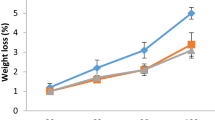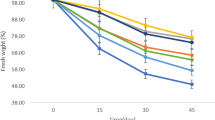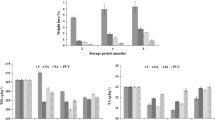Abstract
The study investigated the effects of fludioxonil (FLU) on the postharvest quality of pomegranate fruit (cv. Wonderful). Fruits were dipped in FLU concentrations (control, 150, 300 and 600 mg/L) and stored for 4 months at 5 °C and 90–95% relative humidity (RH) plus an additional 4 days at 20 °C and 65% RH. Effects of FLU were evaluated on physiological responses, quality and sensory attributes. Results showed that fruit weight loss and decay incidence were reduced by FLU treatment, with fruit treated with 600 mg/L concentration showing the best results. Fruit respiration rate was more influenced by storage duration than FLU concentration. The severity and occurrence of physiological disorders increased with storage duration but were more pronounced in fruits treated with FLU. Storage duration influenced fruit colour whereas aril colour was affected by FLU concentration. Untreated fruit showed better aril redness and chroma although treated fruit also had acceptable red colour. Chemical quality attributes of fruit juice were not significantly affected by FLU concentrations. Fruit treated with FLU had significantly (p < 0.05) higher total phenolic content during storage although lower ascorbic acid content was observed compared to untreated fruit. Treating fruit with FLU resulted in better sensory attributes with regards to crispness, juiciness and sweetness. Overall, this study showed that fruit treated with FLU at 600 mg/L had the best quality with respect to decay incidence, weight loss, total phenolics and sensory attributes.







Similar content being viewed by others
Abbreviations
- FLU:
-
Fludioxonil
- BMC:
-
Benzimidazole carbamate
- TBZ:
-
Thiabendazole
- US E.P.A:
-
United States Environment Protection Agency
- AI:
-
Active ingredient
- SE:
-
Standard error
- TA:
-
Titratable acidity
- TSS:
-
Total soluble solids
- MPA:
-
Metaphosphoric acid
- CI:
-
Chilling injury
- AA:
-
Ascorbic acid
- GAE:
-
Gallic acid equivalent
References
S.K. Roy, D.P. Waskar, Pomegranate in Postharvest Physiology and Storage of Tropical and Subtropical Fruits, ed. by S Mitra (CAB International, Wallingford, 1997), pp. 365–374
F.A. Al-Said, U.L. Opara, R.A. Al-Yahyai, Physico-chemical and textural quality attributes of pomegranate cultivars (Punica granatum L.) grown in the sultanate of Oman. J. Food Eng. 90, 129–134 (2009)
U.L. Opara, M.R. Al-Ani, Y.S. Al-Shuaibi, Physico-chemical properties, vitamin C content, and antimicrobial properties of pomegranate fruit (Punica granatum L.). Food Bioprocess Tech. 2, 315–321 (2009)
S.A. Al-Maiman, D. Ahmad, Changes in physical and chemical properties during pomegranate (Punica granatum L.) fruit maturation. Food Chem. 76, 437–441 (2002)
O.A. Fawole, U.L. Opara, Effects of storage temperature and duration on physiological responses of pomegranate fruit. Ind. Crop. Prod. 47, 300–309 (2013)
E.P. Lansky, R.A. Newman, Punica granatum (pomegranate) and its potential for prevention and treatment of inflammation and cancer. J. Ethnopharmacol. 109, 177–206 (2007)
O.A. Fawole, N.P. Makunga, U.L. Opara, Antibacterial, antioxidant and tyrosinase inhibition activities of pomegranate fruit peel methanolic extract. BMC complement. Altern. Med. 12, 1–11 (2012)
S.U. Mertens-Talcott, P. Jilma-Stohlawetz, J. Rios, L. Hingorani, H. Derendorf, Absorption, metabolism, and antioxidant effects of pomegranate (Punica granatum L.) polyphenols after ingestion of a standardized extract in healthy human volunteers. J. Agr. Food Chem. 54, 8956–8961 (2006)
M. Aviram, N. Volkova, R. Coleman, M. Dreher, M.K. Reddy, D. Ferreira, M. Rosenblat, Pomegranate phenolics from the peels, arils, and flowers are antiatherogenic: studies in vivo in atherosclerotic apolipoprotein E-deficient (E0) mice and in vitro in cultured macrophages and lipoproteins. J. Agric. Food Chem. 56, 1148–1157 (2008)
E. Arendse, O.A. Fawole, U.L. Opara, Influence of storage temperature and duration on postharvest physico-chemical and mechanical properties of pomegranate fruit and arils. J. Food 12, 389–398 (2014)
S. D’Aquino, M. Schirra, A. Palma, A. Angioni, P. Cabras, A. Gentile, E. Tribulato, T. Agroalimentari, Effectiveness of fludioxonil in control storage decay on pomegranate fruit. Acta Hortic. 818, 313–318 (2009)
R. Labuda, K. Hudec, E. Piecková, J. Mezey, R. Bohovič, S. Mátéová, S.S. Lukáč, Penicillium implicatum causes a destructive rot of pomegranate fruits. Mycopathologia 157, 217–223 (2004)
H. Förster, G.F. Driever, D.C. Thompson, J.E. Adaskaveg, Postharvest decay management for stone fruit crops in California using the “reduced-risk” fungicides fludioxonil and fenhexamid. Plant Dis. 91, 209–215 (2007)
D. Errampalli, N.R. Brubacher, J.R. DeEll, Sensitivity of Penicillium expansum to diphenylamine and thiabendazole and postharvest control of blue mold with fludioxonil in ‘McIntosh’apples. Postharvest Biol. Tech. 39, 101–107 (2006)
M.L. Gullino, P. Leroux, C.M. Smith, Uses and challenges of novel compounds for plant disease control. Crop Prot. 19, 1–11 (2000)
M. Schirra, S. D’Aquino, A. Palma, S. Marceddu, A. Angioni, P. Cabras, B. Scherm, Q. Migheli, Residue level, persistence, and storage performance of citrus fruit treated with fludioxonil. J. Agr. Food Chem. 53, 6718–6724 (2005)
J.E. Adaskaveg, L. Kanetis, A. Soto-Estrada, H. Förster, A new era of postharvest decay control in citrus with the simultaneous introduction of three new ‘reduced-risk’ fungicides. Proc. Int. Soc. Citricult. 10, 999–1004 (2004)
H.J. Rosslenbroich, D. Stuebler, Botrytis cinerea-history of chemical control and novel fungicides for its management. Crop Prot. 19, 557–561 (2000)
L. Vaquero-Fernández, A. Sáenz-Hernáez, J. Sanz-Asensio, P. Fernández-Zurbano, M. Sainz-Ramírez, B. Pons-Jubera, M. López-Alonso, S.-I. Epifanio-Fernández, M.T. Martínez-Soria, Determination of cyprodinil and fludioxonil in the fermentative process of must by high-performance liquid chromatography–diode array detection. J. Sci. Food Agr. 88, 1943–1948 (2008)
M. Brycht, B. Burnat, S. Skrzypek, V. Guzsvány, N. Gutowska, J. Robak, A. Nosal–Wiercińska, Voltammetric and corrosion studies of the fungicide fludioxonil. Electrochim. Acta 158, 287–297 (2015)
S. D’Aquino, A. Palma, M. Schirra, A. Continella, E. Tribulato, S. La Malfa, Influence of film wrapping and fludioxonil application on quality of pomegranate fruit. Postharvest Biol. Tech. 55, 121–128 (2010)
E. Feliziani, G. Romanazzi, D.A. Margosan, M.F. Mansour, J.L. Smilanick, Effect of field treatments with fungicide, potassium sorbate, or chitosan on postharvest rots and quality of table grapes. Proc. IInd IS on Discovery and development of innovative strategies for postharvest disease management Eds.: M. Wisniewski et al. Acta Hort 1053, 257–264 (2014)
O.J. Caleb, P.V. Mahajan, U.L. Opara, C.R. Witthuhn, Modelling the respiration rates of pomegranate fruit and arils. Postharvest Biol. Tech. 64, 49–54 (2012)
F. Artes, J.A. Tudela, M.I. Gil, Improving the keeping quality of pomegranate fruit by intermittent warming. Eur. Food Res. Technol. 207, 316–321 (1998)
P.B. Pathare, U.L. Opara, F.A.J. Al-Said, Colour measurement and analysis in fresh and processed foods: a review. Food Bioprocess Tech. 6, 36–60 (2013)
O.A. Fawole, U.L. Opara, Changes in physical properties, chemical and elemental composition and antioxidant capacity of pomegranate (cv. Ruby) fruit at five maturity stages. Sci. Hort. 150, 37–46 (2013)
L. Barros, M. Ferreira, B. Queiros, I.C.F.R. Ferreira, P. Baptista, Total phenols, ascorbic acid, β-carotene and lycopene in Portuguese wild edible mushrooms and their antioxidant activities. Food Chem. 103, 413–419 (2007)
H.P.S. Makkar, P. Siddhuraju, K. Becker, Plant secondary metabolites (Humana Press. Inc, New Jersey, 2007), pp. 74–75
L. Chen, U.L. Opara, Texture measurement approaches in fresh and processed foods—a review. Food Res. Int. 51, 823–835 (2013)
L. Vázquez-Araújo, K. Koppel, E. Chambers IV, K. Adhikaria, A.A. Carbonell-Barrachina, Instrumental and sensory aroma profile of pomegranate juices from the USA: differences between fresh and commercial juice. Flavour Frag. J. 26, 129–138 (2011)
K. Barman, R. Asrey, R.K. Pal, Putrescine and carnauba wax pretreatments alleviate chilling injury, enhance shelf life and preserve pomegranate fruit quality during cold storage. Sci. Hort. 130, 795–800 (2011)
S. D’Aquino, A. Palma, A. Angioni, M. Schirra, Residue levels and efficacy of fludioxonil and thiabendazole in controlling postharvest green mold decay in citrus fruit when applied in combination with Sodium bicarbonate. J. Agric. Food Chem. 61, 296–306 (2013)
H.M. Yehia, Heart rot caused by Aspergillus niger through splitting in leathery skin of pomegranate fruit. Afr. J. Microbiol. Res. 7, 834–837 (2013)
D. Ezra, B. Kirshner, M. Hershcovich, D. Shtienberg, I. Kosto, Heart rot of pomegranate: disease etiology and the events leading to development of symptoms. Plant Dis. 99, 496–501 (2015)
S.H. Mirdehghan, M. Rahemi, Effects of hot water treatment on reducing chilling injury of pomegranate (punica granatum) fruit during storage. Proc. 5th Int. Postharvest Symp. Acta Hortic. 682, 887–892 (2005)
S.H. Mirdehghan, M. Rahemi, S. Castillo, D. Martínez-Romero, M. Serrano, D. Valero, Pre-storage application of polyamines by pressure or immersion improves shelf-life of pomegranate stored at chilling temperature by increasing endogenous polyamine levels. Postharvest Biol. Tech. 44, 26–33 (2007)
S. D’Aquino, M. Schirra, A. Gentile, E. Tribulato, S. La Malfa, A. Palma, Postharvest lecithin application improves storability of ‘Primosole’ pomegranates. Acta Hortic. 934, 733–739 (2012)
Y.L. Zhang, R.G. Zhang, Study on the mechanism of browning of pomegranate (Punica granatum L. cv. Ganesh) peel in different storage conditions. Agr. Sci. China. 7, 65–73 (2008)
E. Arendse, O.A. Fawole, U.L. Opara, Effects of postharvest storage conditions on phytochemical and radical-scavenging activity of pomegranate fruit (cv. Wonderful). J. Hort. Sci. 169, 125–129 (2014)
M. Sayyari, S. Castillo, D. Valero, H.M. Díaz-Mula, M. Serrano, Acetyl salicylic acid alleviates chilling injury and maintains nutritive and bioactive compounds and antioxidant activity during postharvest storage of pomegranates. Postharvest Biol. Tech. 60, 136–142 (2011)
S.M. Elyatem, A.A. Kader, Post-harvest physiology and storage behaviour of pomegranate fruits. Sci. Hort. 24, 287–298 (1984)
B.G. Defilippi, B.D. Whitaker, B.M. Hess-Pierce, A.A. Kader, Development and control of scald on Wonderful pomegranate during long-term storage. Postharvest Biol. Tech. 41, 234–243 (2006)
Acknowledgements
This work is based upon research supported by the South African Research Chairs Initiative of the Department of Science and Technology and National Research Foundation. The authors are grateful to the South African Postharvest Innovation Programme (PHI) and Pomegranate Growers’ Association of South Africa (POMASA) for the award of a research grant.
Author information
Authors and Affiliations
Corresponding author
Rights and permissions
About this article
Cite this article
Atukuri, J., Fawole, O.A. & Opara, U.L. Effect of exogenous fludioxonil postharvest treatment on physiological response, physico-chemical, textural, phytochemical and sensory characteristics of pomegranate fruit. Food Measure 11, 1081–1093 (2017). https://doi.org/10.1007/s11694-017-9485-6
Received:
Accepted:
Published:
Issue Date:
DOI: https://doi.org/10.1007/s11694-017-9485-6




